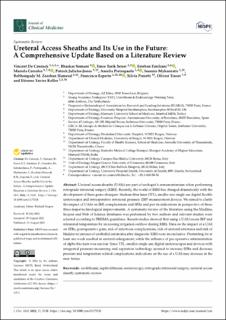Ureteral access sheaths and its use in the future: A comprehensive update based on a literature review
De Coninck, Vincent; Somani, Bhaskar; Sener, Emre Tarik; Emiliani, Esteban; Corrales, Mariela; Jones, Charles Patrick Warburton; Pietropaolo, Amelia; Mykoniatis, Ioannis; Zeeshan Hameed, Belthangady M.; Esperto, Francesco; Proietti, Silvia; Traxer, Olivier; Keller, Etienne Xavier
Journal article, Peer reviewed
Published version

Åpne
Permanent lenke
https://hdl.handle.net/11250/3030227Utgivelsesdato
2022-08-31Metadata
Vis full innførselSamlinger
- Department of Clinical Medicine [2046]
- Registrations from Cristin [9553]
Sammendrag
Ureteral access sheaths (UASs) are part of urologist’s armamentarium when performing retrograde intrarenal surgery (RIRS). Recently, the world of RIRS has changed dramatically with the development of three game-changers: thulium fiber laser (TFL), smaller size single use digital flexible ureterosopes and intraoperative intrarenal pressure (IRP) measurement devices. We aimed to clarify the impact of UASs on IRP, complications and SFRs and put its indications in perspective of these three major technological improvements. A systematic review of the literature using the Medline, Scopus and Web of Science databases was performed by two authors and relevant studies were selected according to PRISMA guidelines. Recent studies showed that using a UAS lowers IRP and intrarenal temperature by increasing irrigation outflow during RIRS. Data on the impact of a UAS on SFRs, postoperative pain, risk of infectious complications, risk of ureteral strictures and risk of bladder recurrence of urothelial carcinoma after diagnostic RIRS were inconclusive. Prestenting for at least one week resulted in ureteral enlargement, while the influence of pre-operative administration of alpha-blockers was unclear. Since TFL, smaller single use digital ureteroscopes and devices with integrated pressure-measuring and aspiration technology seemed to increase SFRs and decrease pressure and temperature related complications, indications on the use of a UAS may decrease in the near future.
